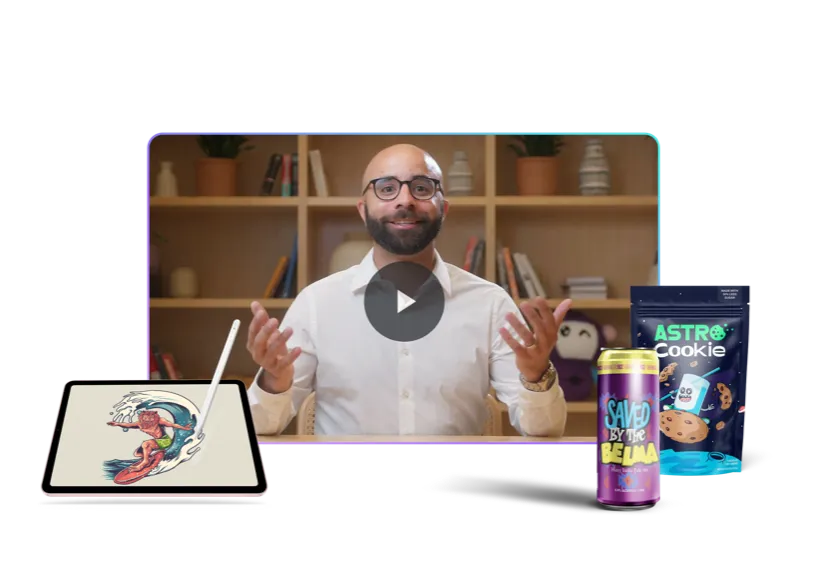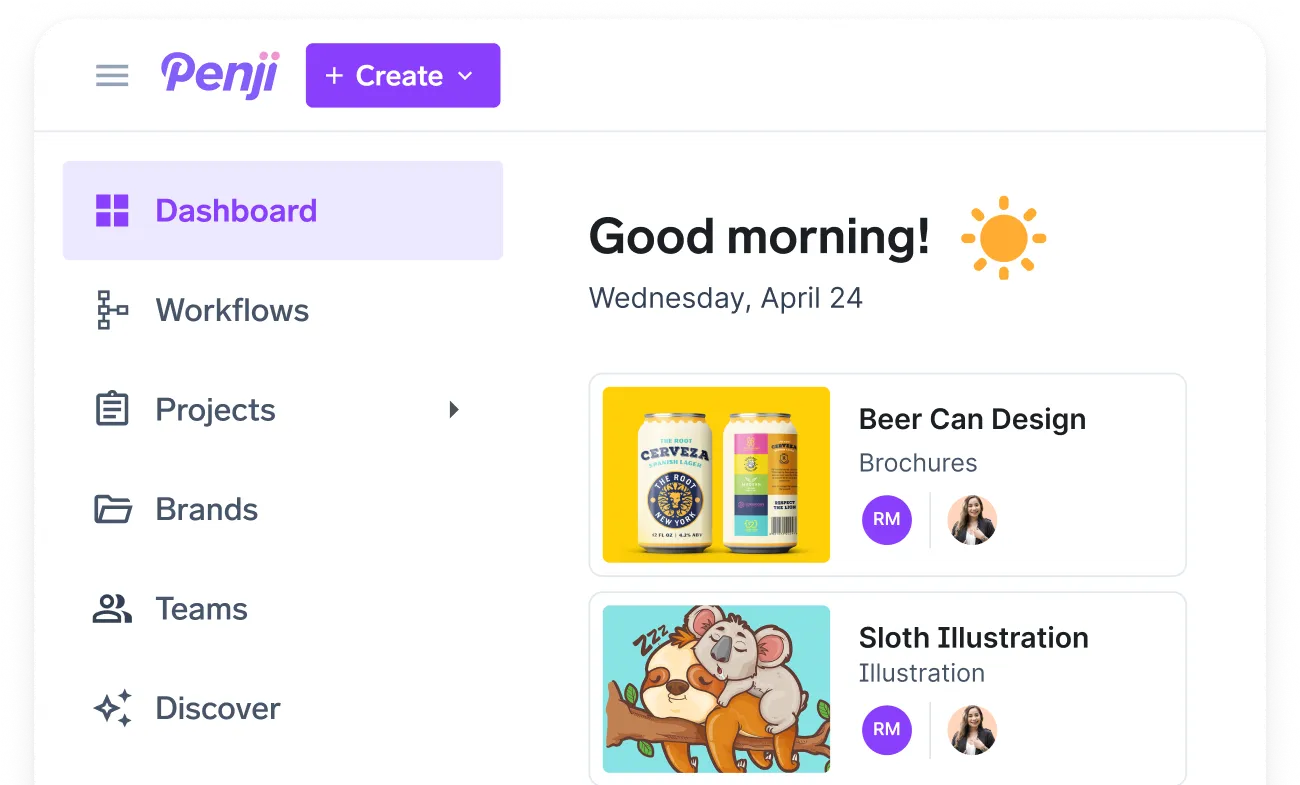![[Fully Managed] Udi Ledergor from Gong Ep. 176](https://penji.co/wp-content/uploads/2025/08/BLOG-IMAGE-Udi-Ledergor.jpg)
Daniela: Hello everybody, welcome to the First One Hundred podcast. This is the podcast where we’re going to be exploring the journey of entrepreneurs, business owners, agency leaders and so many more people that will be sharing with us the strategies, the challenges and the triumphs that led them to secure those first one hundred customers. I’m very excited today because we have a really great guest. Udi, hi Udi, how are you?
Udi: I’m great Daniela, thanks for having me.
Daniela: Thank you so much for being here.
Getting to Know Udi
Daniela: Just to break the ice, as we get started, can you tell us a little bit about yourself, who you are, what you do, the whole shebang?
Udi: Sure. I’m Udi Ledergor, originally from Tel Aviv, Israel. I’ve been living in San Francisco, California for the last six and a half years with my family. I work for Gong. It’s my ninth year, I think, at Gong. Most of that time, I led Gong’s marketing as chief marketing officer. And in the last couple of years, I have transitioned into my new role as chief evangelist. So I get to go deeper on things that I’m excited about. What else in my spare time? I like playing the piano, drinking wine and whiskey, working out at the gym and hiking. I think that covers it.
Daniela: Awesome. Interesting. I went to San Francisco last year, and it was super cold and I wasn’t expecting for the weather to be so cold when I got there. Cause it’s usually like chilly, but not as cold. I think they were having like a cold front or something.
Udi: Yeah, but it’s really nice. It’s pretty constant here. We joke that we have three seasons, the morning, noon, and afternoon. So you need a jacket in the morning and in the evening, but usually you can take it off around lunchtime.
Daniela: Yeah, no, for real. But I live in El Salvador and it’s the same thing. Like evening and morning weather is colder and then the rest of the day you’re boiling. It’s like ridiculous. But Udi, so great to have you here. Now, you mentioned that you’ve been at Gong for ten years, right?
Udi: It’s my ninth year, so about eight and a half.
About Gong
Daniela: Nine and a half, okay. Can you tell us a little bit about Gong? How did you end up there? What your mission is with them? What Gong’s mission is a little bit?
Udi: Sure, so Gong is all about unlocking companies’ revenue potential. And we do this with our revenue intelligence platform, which helps salespeople understand what’s happening in their customer conversations, uplevel their skills, which leads to more growth, more predictability, and more productivity. So we’re using AI to automate everything that can be automated so that the salesperson and their leaders can spend time on things that we are actually qualified to do as humans, like strategize and close more deals and spend more time with customers instead of updating our CRM and taking notes during calls and updating our manager what she said or what he said. AI can do all of that. And it also is used to guide humans on how to prioritize what they need to do. So that’s Gong’s mission.
I joined Gong as employee number thirteen and marketer number one back in twenty sixteen. We’re now a little bit bigger company at about thirteen hundred employees with almost five thousand customers and hundreds of millions in revenue. So companies do really, really well. As I mentioned, I joined as the first marketer. So I had the privilege and honor of building Gong’s marketing efforts for the first six and a half or so years. It’s been quite the wild ride and I look forward to the next chapter.
Building from the Ground Up
Daniela: Wow. So you were there at the beginning and now you’re sort of seeing the growth of this incredible thing. And I know that you have had leadership roles in other companies before you went to Gong, which makes me curious. How have all of the experiences that you had before shaped the way that you approached marketing, specifically here, that you were building it from the ground up?
Udi: Yeah, I’ve led five marketing teams. That’s been the bulk of my career. And in between, I’ve also done board work, advisory work, some consulting, a lot of speaking. And everything I do, I try to take away something that’s going to help me next time around. So I think I learned how to pick companies a little bit better based on their leadership and product potential, because I definitely made some mistakes in the past with that.
You asked how I ended up at Gong, which is an interesting story. So my CEO, Amit Bendov and I have worked together at three different companies now. So for the last twenty five years or so, we’ve worked on and off three different companies together. And it was great to get his call all those years ago saying, “Hey, Udi, we rolled out the product to twelve beta customers and eleven of them became paying customers in three months. We want to start marketing this thing. Can you come help?” And I said, “Yes, I can come help.” And the rest, as they say, is history.
So I think developing a relationship with people you work with and staying top of mind for them so that they call you and bring you to their next adventure, if you’re good enough and they enjoy working with you, that’s probably a good career tip for all of us.
The Importance of Networking
Daniela: Yeah, you know, like networking is actually really big. I feel like nowadays with social media and all of these sort of technological advances, we tend to put that in the back burner, but talking to people, networking is huge still. I think that’s never going to go away.
Udi: Networking is huge, but there’s nuance to it. Some people just show up at conferences and are looking for a job. That’s probably the laziest form of networking. What I was alluding to was something much deeper of actually build relationships with people, not just at happy hours and conferences and actually do great work that you become known for. And that’s when people want to see more of you and want more of your work.
Daniela: Yeah, to make yourself valuable for them, right?
Udi: Exactly.
Marketing AI and Educating Customers
Daniela: So I’ve actually got some questions about the nature of Gong because you have integrated AI to improve revenue productivity, which is huge. But I also think it can be, I suppose, very hard to market or advertise because I feel like we are at a stage where unless you’re very into the tech world or, you know, you’re into like AI and advancements like that, there’s a huge portion of the population that doesn’t understand a lot of these advancements one hundred percent or even an eighty percent. So it makes me wonder, how do you actually educate potential customers, potential clients, potential companies that could benefit from Gong of what you can do for them, especially if they’re wary of AI, if they don’t fully understand AI or what AI can do for them?
Udi: Yeah, it’s a great topic and I always start with what does the audience care about? That’s usually the best way to approach these messaging and positioning challenges. If you start talking about what you’ve built and how excited about the bits and bolts and all the things under the hood, you’re probably going to lose your audience very quickly because nobody really cares about that except a few nerds that might be interested in what you’re building. But if you talk to your customers about their problem and show them that you really understand their problem, now they’re listening and leaning in. And then you can say, “Well, I can help you solve that.” And then they want to learn more.
So, it’s very rare that we’re trying to develop messaging for everyone or that we want everyone to know what we’re doing because nobody creates a product for everyone. But if you really understand your customer and you know how they describe their problem and it’s painful and it’s what’s keeping them up at night and they would love for you to come and solve that for them, that’s usually a better route to getting their attention.
And so that’s what we were doing all the years. Gong was doing AI since twenty fifteen. But until recently, when everyone started talking about it, we didn’t really put AI on our website or on our marketing materials. We talked to sales leaders who said, “Hey, isn’t it crazy that you don’t know what’s happening in your team’s sales conversation because they probably speak about six thousand words in an hour call with a customer but only twenty five words end up in your CRM and that happens about a week later when you forced them to do it. Don’t you wish you knew which customers they were talking to, how they’re delivering the pitch, how are they talking about discounts, and that you could spend time with them winning more deals instead of interrogating them on what happened?”
And sales leaders said, “Yeah, of course we’d want to do that.” And then we’d show them our solution. So here’s what we do. We use AI to capture all these customer conversations, and then we analyze it, and then we pull out these insights and automation, and then the solution becomes very relevant because it solves a very real pain that customers told us that they’re having.
And so that’s usually the starting point. And if you have to talk about how it works and how terrific the technology is, great. But that’s rarely where we begin with. We usually begin with, as Simon Sinek famously said, start with why. Why are we doing this? Because you have this problem. Okay, so what do we do? Here’s the solution that we created. Oh, now you’re interested? Let me show you how it works. So starting with why, and then going to the what, and then ending up with the how, if someone’s still interested in sticking around for that, that’s usually the right cadence.
Daniela: Yeah, definitely like big words are not going to stick at the beginning, right? Use their language, not yours.
Udi: Yeah, for sure.
Customer Feedback and Product Development
Daniela: Which actually, I know that you guys at Gong really emphasize customer feedback. I know that you also analyze a lot of the customer interactions. You use this to transform outcomes for clients and stuff. What role exactly does that customer feedback play in refining the product itself? How do you ensure that your customers’ voices are what are shaping the growth of this company especially since it’s been – I mean I imagine there’s a lot been going on that has changed, evolved, grown.
Udi: Yeah, the customer voice plays a major part in what we do. I think what we do is a very healthy combination of product-led innovation which means our product team has a roadmap and compiles all these requests and feedback from customers into themes. And as Henry Ford famously said, “If I ask people what they want, they’d ask for faster horses.” So most people can’t imagine the car before they’ve ever seen one. That was Henry Ford’s genius. So I think we do that with coming up with things that solve people’s problems, even if they can’t imagine the solution yet.
But as we do that, we’re very open to feedback and requests on how to refine the product to make it more useful. And we use our own AI technology to capture all these requests. When customers talk to a salesperson, a support person, a customer success person, they can easily tag that for the product team to listen to and stack rank that so they know what customers are asking for. If a certain request comes up on thirty calls, that’s probably going to get more priority than someone who asked for a feature and he’s the only one who asked for it. We use our own AI to collect a lot of those requests that show up on customer conversations, and many of our customers do that as well.
Our product team is probably better connected with our customers than at any company that I’ve ever seen before, and that makes a real difference. Many times, the product team kind of stays shielded in their silo and develops their own thing. And occasionally they’ll get feedback from sales or support about something a customer said. But our product team is really embedded in our customer conversations, not only through using our AI to pick up conversations where they’re not part of, but actually directly having conversation with customers during the requirement stage, during the alpha testing stage, during the beta testing stage. And then, of course, when the product is in general availability, they’ll continue to speak with customers who are very, very friendly because they love the value that they’re getting and they love having part in shaping our future product. So they get to speak with product and provide feedback. And so it’s a win-win.
Customers love that influence that they have on our product roadmap. And our product team gets that very important direct feedback, which helps them shape the next generation of products.
Daniela: That’s amazing. Yeah. I mean, I think connection with the customer, I feel like as a customer myself for whatever product I’ve consumed, sometimes you feel like if your frustration, you’re just putting into a random platform and it’s going to go nowhere. It can feel like your voice isn’t being heard. So huge. Nobody wants to fill out a form.
Udi: Yeah. Nobody wants to just have like the ticket floating over there for someone to go through it one day and then leave it.
Daniela: Right. So that’s huge.
AI Evolution and Impact
Daniela: And actually it leads me to my other question, which is obviously customer reviews are very important for you and the advancement of your product. But because Gong is so deeply connected with AI, it makes me wonder how is the massive and rapid change in AI influencing also the way that you are evolving the product? I mean, AI is also becoming more ubiquitous. It’s very controversial. A lot of sort of ethical questions are being brought up. Laws are being changed around it. How does this affect you guys and the product and the development with marketing, with business development, with all of these different things?
Udi: So when we look at the product, I said our mission is to help companies unlock revenue potential and grow their business and win their markets. And we look at advancements in AI in the foundational models and components that we could embed in our product to make it better and faster and help our customers unlock more potential for revenue. So that’s the lens that we look through. Obviously in the last couple of years, there’s been amazing progress with generative AI and other components of AI that have allowed us to provide that much more value to our customers.
Things that were impossible to do are now hard to do. Things that were hard to do are now easy to do. And that’s how we’re evolving our product, but it’s all focused on what’s going to bring our customers more value based on what we heard from them about their challenges, their pains, their problems, not just a shiny new object that someone in engineering thought would be fun to play with. We do have research teams that play with things that think they might have a long-term potential and some of them make it into the product, others don’t.
Just this week, we had our annual Gongathon, which is basically a hackathon where the engineering and product teams take ideas from our go-to-market teams, which means these are challenges that customers are having and wishes that they have that the product could do. And they experiment for a few days, seeing what could we do without trying to build a production-ready product, just doing a quick and dirty demo. And a lot of these projects make their way into the product eventually because they look so amazing and they can provide so much value that several of the features and capabilities that we released this year started out in previous years hackathons and they made it into the product.
So we’re always looking at what’s happening out there. We have some of the world’s top researchers on AI working on these problems in their roles at Gong. And it’s always looking through the lens of what can we do to provide more value to customers where we know that there’s a lot of confusing, shiny tools out there that are usually no more than a thin skin over a Chat GPT or another generic model. Our large enterprise customers definitely understand that they can’t be using those and they can’t let their team use those if they don’t have enterprise-grade security and privacy compliance, and they’re not trained on actual sales data.
Chat GPT is amazing, and I use it for many things, but I wouldn’t use it for improving my pitch to customers because it knows nothing about my product, my market, my customers, and my competitors because it wasn’t trained on that. But Gong has all that information. We have billions of sales conversations trapped in Gong that we can train our models on. And that’s why our models are very, very helpful to salespeople.
So as far as the controversy goes, what we’re seeing is that salespeople and leaders are very receptive when AI can automate mundane, low value tasks that they hate doing, they’re not very good at doing, and they wish they didn’t have to do in the first place. So people don’t argue about something else coming in and writing their notes in the CRM or taking notes during the call or drafting email to send to the customer with all the information that they just captured in the call or reporting back to the manager what happened. All that can be automated away with AI.
And then we use AI to carefully guide the individuals on what we suggest they should be doing next. But they’re the ones who ultimately make the call. So we’re empowering sales professionals to do their jobs better. We’re not replacing them. We’re not doing something that they would be embarrassed if it happened in their place.
Daniela: Yeah, no, you’re just, I feel like from what you speak of and what I’ve been reading, and I was doing investigations on you guys and everything, you more just like boost productivity at the end of the day, you know, like you’re helping.
Udi: Productivity is an important part of it, but we also improve predictability and growth. Predictability means, do we know how this quarter is going to end at the salesperson level, at the team level, at the company level? Because forecasting is very, very important. The whole company budget depends on them knowing how much is going to close. And we can help with that predictability and we can help with growth means meaning we can improve win rates. We can improve outcomes. But productivity is the third pillar. So that’s a very big one as well.
The Future of Work with AI
Daniela: Yeah, no, I mean, I definitely think like it’s more of like a tool to help make – excuse me – to make that process a lot easier than it actually is replacement, which I think is a huge misconception that most people have with AI is that, oh, it’s going to take away my job or it’s going to take away what I do. I certainly do think that AI might change the nature of a lot of jobs and maybe some people from the older generation will feel left out. But as you transition out of the workforce and new people come in, they’re going to have to sort of learn to work with this new tool that is happening, right?
Udi: Yes, I’d say the majority of the impact in the near future is that professionals who know how to use AI well are going to replace professionals who don’t know how to use AI well. And also, we’re going to see some professions go out of fashion. When was the last time you had a TV repair person come in and open up your TV and repair it? You don’t because today we just throw out the TV and buy a new one. When was the last time the milkman paid you a visit to refill your milk bottles or the ice person who brought ice to your door on a wagon. Those people don’t have jobs anymore because technology has evolved and they’ve had to move on and learn a new skill and new profession.
So that’s probably not going to happen to very good salespeople who know how to manage a complex B-to-B sales cycle. They’re just going to have to learn how to do that with AI. But a transactional SDR calling people and reading the same script over and over, that will probably be replaced by AI.
Daniela: Yeah. Well, I mean, I feel like I didn’t even remember that people used to like bring ice on wagons. I don’t think I was…
Udi: Probably not in your lifetime. Honestly, it was probably not in mine either. But it’s just one of those things that used to happen.
Daniela: Yeah, I was thinking like, why not just make it yourself? But it’s insane. Not every house had a fridge at some point.
Udi: I know you find this hard to believe. A hundred years ago, people did not have fridges.
Daniela: But it’s insane. I mean, I totally understand because I do think that a lot has changed. And for example, Penji, we are doing creative work for our customers and we’ve also been affected by AI, but in a way where like we’re integrating it into our process as well. We do graphic design, for example, and it’s not like our designers are going to be completely replaced by AI because that’s impossible. You’re going to need graphic designers at some point in your life if you are a business owner, but the way that you’re going to do that graphic design is going to change, right? Like that graphic designer needs to integrate AI into their process is what we’ve experienced as well.
Udi: Yeah. I think it’s going to be woven into pretty much any profession.
Daniela: Yeah. Any industry, I think, because everyone I think is trying to like AI is just helping optimize so many things like just Chat GPT itself in me and my personal life helps me so much. Like I don’t remember my life without it.
Udi: Absolutely.
Rapid Fire Round
Daniela: Yeah. Well, Udi, it’s almost time for us to finish, but I do have a game prepared for you. It’s a rapid fire of twenty questions. Essentially, we’re going to have a one minute timer to go through all of them. No pressure, but maybe a little bit of pressure. Nobody has been able to get through twenty, and I’m trying to get somebody to get through all twenty. And they’re not related to marketing. They’re not related to AI, social, nothing like that. These are just fun questions.
My advice, don’t think too hard, even if your answer is a lie, if you want to win this game, because all of my guests have been losers so far. Okay. So I’m going to set the timer on my phone. I’ll read the questions and then we can start.
Udi: Okay.
Daniela: Coffee or tea?
Udi: Coffee.
Daniela: Early bird or night out?
Udi: Early bird.
Daniela: Favorite social media platform?
Udi: LinkedIn.
Daniela: Go-to karaoke song?
Udi: I want to break free.
Daniela: Books or podcasts?
Udi: Books.
Daniela: One word that describes you?
Udi: Fun, I hope.
Daniela: Dream vacation destination?
Udi: Palm Springs.
Daniela: Most used app on your phone?
Udi: LinkedIn, Facebook.
Daniela: Favorite emoji?
Udi: The kiss thing.
Daniela: What’s your hidden talent?
Udi: I play the piano.
Daniela: Go-to comfort food?
Udi: Pasta.
Daniela: Superpower you’d want for a day?
Udi: Flying.
Daniela: Who inspires you the most?
Udi: Kermit the Frog.
Daniela: Guilty pleasure?
Udi: Wine and whiskey.
Daniela: All right. We got through fifteen. Close enough. That was pretty good. You still didn’t win my challenge, but you did get the highest. Fifteen is the record number of questions that I’ve gotten through. You’re in the number one spot with the other people that have gotten to fifteen.
Udi: Awesome.
Closing and Contact Information
Daniela: Well, Udi, it’s been great having you today. We’re almost out of time, but I do want to give you, before we go away, the space to talk about anything that you want to talk about. The floor is yours to plug anything. If anybody wants to connect with you, if anybody feels like any of this resonated with them and they want to go to Gong or they want to go to you, the floor is yours.
Udi: Sure. I mean, if your sales team is crushing targets every single quarter and you don’t know what to do with more revenue and pipeline, then you don’t have to do anything. But if you’re not quite there yet, you should definitely go to Gong.io and ask for your personalized walkthrough of our revenue intelligence platform. We’re helping the world’s biggest and some of the smallest companies as well become the biggest companies using our revenue intelligence platform. I’m also happy to connect with anyone on LinkedIn. There’s only one Udi Ledergor on the platform, so I’m pretty easy to find. And with that, thanks for having me today.Daniela: Well, amazing. Yeah, I will be adding the links for this to the description of this video so that the viewers can go and just go ahead and click on it. Thank you so much for everything, Udi. And everybody else, I will see you on the next episode. Goodbye.









